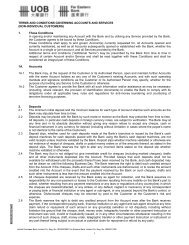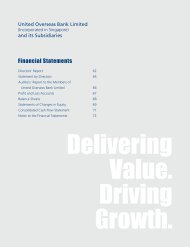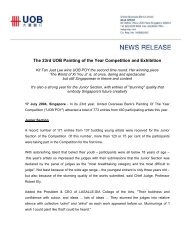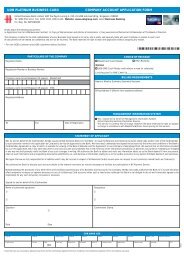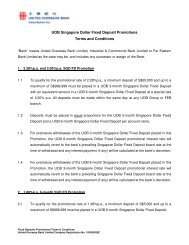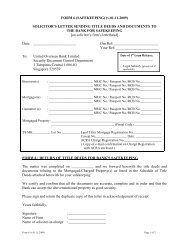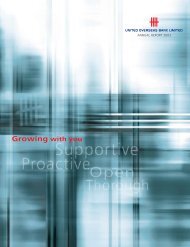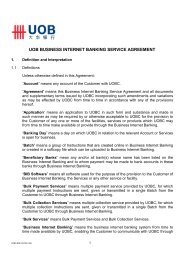UOB Annual Report 2002 - United Overseas Bank
UOB Annual Report 2002 - United Overseas Bank
UOB Annual Report 2002 - United Overseas Bank
Create successful ePaper yourself
Turn your PDF publications into a flip-book with our unique Google optimized e-Paper software.
Risk Management<br />
Operational Risk Management<br />
Operational risk is defined as the potential loss arising from a breakdown in the Group's internal<br />
control or corporate governance that results in error, fraud, failure/delay to perform, or compromise<br />
of the Group's interests by employees. Operational risk also includes the potential loss arising from<br />
a major failure of computer systems and from both natural and man-made disasters. Potential loss<br />
may be in the form of financial loss or other damages, for example, loss of reputation and public<br />
confidence that will impact the Group's credibility and ability to transact, maintain liquidity and<br />
obtain new business.<br />
Operational risk is managed through a framework of policies, techniques and procedures as<br />
approved by the Management Committee under its delegated authority from the Board of Directors.<br />
The decisions of the Management Committee and its monthly risk management reports are<br />
reviewed by the Executive Committee of the Board.<br />
This framework of techniques and procedures encompasses the building of Operational Risk Profiles<br />
(ORPs), the conduct of Operational Risk Self Assessment (ORSA) based on the ORPs, the development<br />
of an Operational Risk Action Plan (ORAP), the monitoring of Key Operational Risk Indicators<br />
(KORIs), and the process for monitoring and reporting operational risk issues.<br />
The methodology provides the tool for the profiling of significant operational risks to which<br />
business and support units are exposed. These units then define the key management policies/<br />
procedures/controls that have been established to address the identified operational risks. The<br />
building of the ORPs involves risk identification as well as the identification and classification<br />
of management controls.<br />
As part of the continual assessment, ORSA provides the business/support heads with an analytical<br />
tool to identify the wider operational risks, assess the adequacy of controls over these risks, and<br />
identify control deficiencies at an early stage so that timely action can be taken.<br />
Where actions need to be taken, these are documented in the form of an ORAP for monitoring<br />
and reporting to top management.<br />
Complementing the framework are KORIs that are utilised and monitored on an on-going basis.<br />
Through regular monitoring and analysis of this data, areas of potential operational control weakness<br />
can be identified at an early stage.<br />
Included in the overall framework of operational risk is the disciplined product programme process.<br />
This process aims to ensure that the risks associated with each new product/service are identified,<br />
analysed and managed before it is approved for launch.<br />
For the implementation of all online products and services, extra precautionary measures are taken<br />
to address and protect customers' confidentiality and interests. Clear instructions are also posted<br />
on the Group's website to advise and educate customers on the proper use and safekeeping of<br />
their access identification and passwords.<br />
48




